We’ve analyzed time tracker records of more than 20,000 people from 97 different countries who were working remotely in 2022. Here’s what we’ve looked into:
- when they started their working day
- when they got off work
- how often they took breaks – and for how long
- and how active they were during their working day
We did not intend to collect or analyze any personal data, such as gender, age, occupation, or position, in order to avoid compromising individual privacy and to ensure that we do not work with micro segments that may not be adequately representative.
Here are the four key takeaways to take into consideration if you want to be more productive when working remotely:
Key Takeaways:
- The correlation between activity and the frequency of breaks during the workday is high, at 83%. This means that taking more breaks while working remotely is recommended. Specifically, taking a break every hour and a half has shown to help maintain high productivity levels.
- Individuals who take only from one to three breaks during the day tend to be the least active. On average, their activity levels are 23% lower compared to those who take four or more breaks.
- Individuals who start working remotely later in the day (between 10 AM and 1 PM) tend to be more active, performing 9% better than those who start working early in the morning (between 5 AM and 9 AM).
- Globally, the time interval between 8 AM and 10 AM remains the most popular time starting a remote work day with approximately 70% of employees beginning their work within this timeframe.
- On average, remote workers in the USA take 5 breaks per day, while those in the UK take 6 breaks and those in Australia take 7 breaks.
How Breaks And Efficiency Are Related
We’ve taken user activity rates across all countries and compared them against the average number of breaks per day. The correlation coefficient of 83% (Pearson’s correlation coefficient) most likely indicates a dependency:
The more often employees take breaks, the more productive and active they are during the working day.
Our observation revealed that individuals who take only from one to three breaks during the day tend to be the least active. On average, their activity levels are 23% lower compared to those who take four or more breaks.
In the study, we’ve found that 82% of the users take four to six breaks during their workday, and their average activity score is 73%. This is a fairly common trend, as these numbers suggest that taking a break approximately every hour and a half during an 8-hour workday is sufficient.
This behavior is similar to what many office workers do: taking short breaks every hour and a half. They might step outside for a smoke, make a cup of coffee or tea, or chat with colleagues for a few minutes. Interestingly, people who take 10 or more breaks per day tend to have high activity levels of 80% or more. These frequent breaks seem to positively affect their engagement and productivity throughout the workday.
Interestingly, individuals who take 10 or more breaks per day tend to exhibit high levels of activity, typically exceeding 80%. These frequent breaks seem to positively impact overall engagement and productivity throughout the workday.
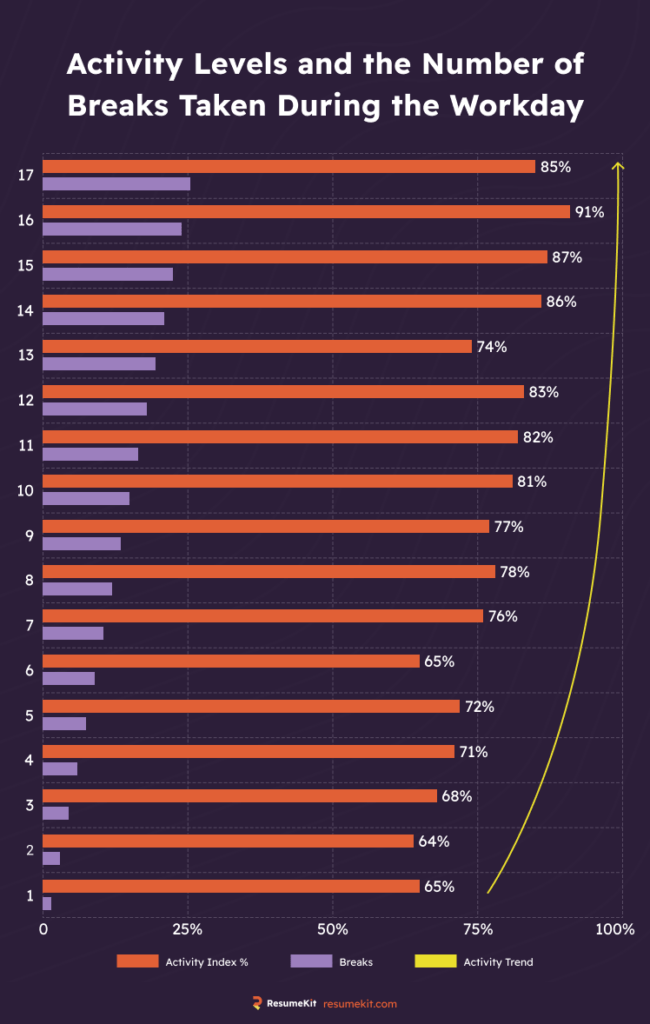
It is important to mention that the activity indicator used in time trackers, which considers mouse and keyboard usage, is a subjective measure and cannot solely determine a person’s productivity or efficiency at work.
Based on our observations, we have noticed that individuals who do not take breaks while working remotely tend to become slower and less attentive. Their engagement and focus on tasks diminish.
Considering these key findings from our research, we recommend that all remote workers take shorter breaks more frequently, ideally every hour. This would allow for approximately seven to eight breaks within an 8-hour workday.
On the flip side, we have observed that employees who take 13-17 breaks during the day demonstrate the highest activity levels.
This raises an interesting point: to achieve, for instance, 16 breaks in an 8-hour workday, one would need to pause the time tracker every 30 minutes.
So do you really need to take breaks that frequently? How does such a high frequency of breaks impact efficiency?
The answer to this question largely depends on the nature of your work and the type of tasks you are engaged in. For simple and repetitive tasks like reading short materials or sending standard emails to clients, it is quite possible to efficiently complete them within a 30-minute timeframe.
However, for tasks like coding, sprinting a project, budgeting, or preparing a presentation, 30-minute iterations are clearly insufficient. With such complex tasks, individuals need longer working intervals of 1-1.5 hours to properly tackle the task or its sub-stages with high quality. Taking frequent breaks in these cases can negatively impact work quality as it takes time for a person to regain focus and productivity after each break, thereby disrupting the flow of work.
The connection between the number of breaks and activity indicators can also be attributed to individuals not pausing the time tracker during short breaks. Even if people with fewer breaks do take short five to ten minute breaks, their activity may show as zero percent (0%) during those times. Consequently, their average daily activity will appear lower due to these unrecorded breaks.
Exploring Work Breaks Across Different Countries
When examining the average number of breaks per day in different countries, we observe slight variations in the averages and ranges. Across all countries, remote workers take an average of 3.8 breaks per day.
Here are the top seven countries where users tend to take the highest number of breaks:
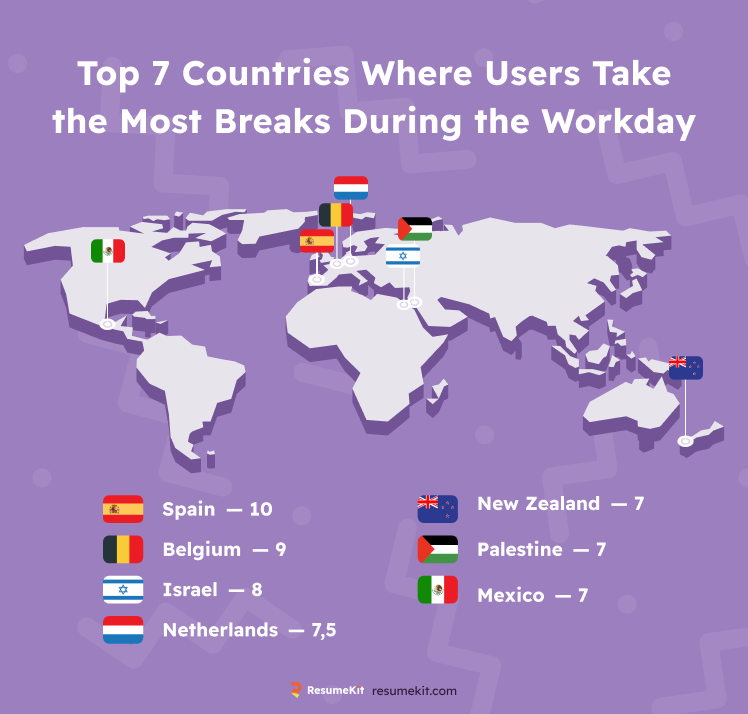
Is there any speculation as to why certain countries have ranked in these positions? It is worth noting that the top five countries with the most breaks are predominantly European, but these observations are unlikely to indicate any definitive trend based on geographical or national characteristics.
Interestingly, some European countries like Denmark, Latvia, and France are also among the countries with the fewest breaks, typically two to three breaks per day.
Now, here are the top seven countries where workers take the fewest breaks:
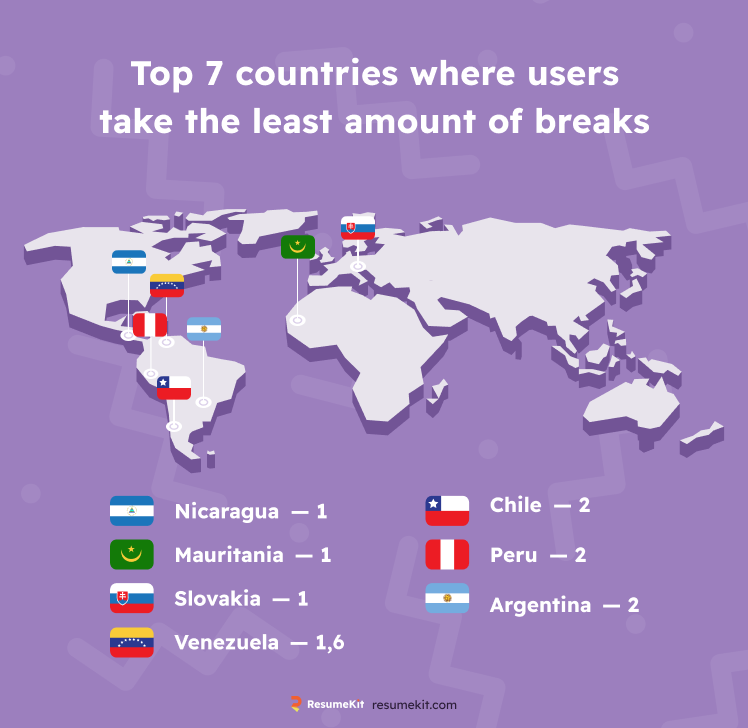
It is interesting to note that the countries with the fewest interruptions are predominantly in Latin America. This suggests that these countries may have a more active work culture. It is worth mentioning that the average activity level in these Latin American countries is not the lowest, standing at 68%.
On average, users in the United States take five breaks per day, while in the United Kingdom, the average is six breaks, and in Australia, it’s seven breaks. Here is a world map showing the average number of breaks taken in different countries during the working day.
When we analyze the data by country, we don’t observe extreme values of 15-17 breaks.
Instead, we see that on average, people need to take four to six breaks while working remotely.
In fact, 70% of the users in this study fall into this group, taking four to six breaks per day.
How the Time a Workday Starts Impacts Activity Levels
People who begin work later in the day (between 10 AM and 1 PM) exhibit 9% higher activity levels compared to those who start in the morning (between 5 AM and 9 AM). The correlation between start time and activity metrics is significant at 82% (Pearson’s correlation coefficient), indicating a likely relationship between the two.
Those who start work from 11 AM to 1 PM demonstrate the highest activity levels, with an average activity of approximately 75%. On the other hand, employees who start working between 5 AM and 9 AM show the lowest activity rates, averaging at around 68%.
These findings highlight the impact of the workday’s start time on activity metrics, suggesting that beginning work later in the morning may positively influence overall activity levels.
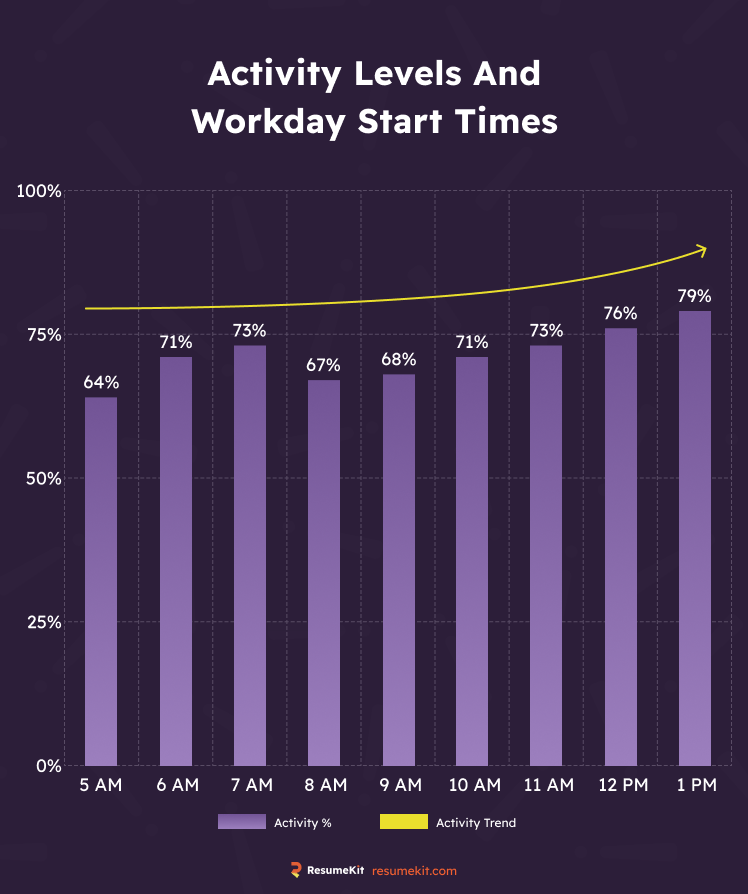
Those who finish work later in the day (between 1 PM and 3 PM) also demonstrate better activity levels compared to those who finish earlier (between 10 AM and 12 PM).
When Different Countries Start Their Work Day
When calculating the weighted averages of workday start times across countries, we’ve observed that the most common time is between 8 AM and 10 AM. Approximately 70% of employees in most countries begin their work during this time interval.
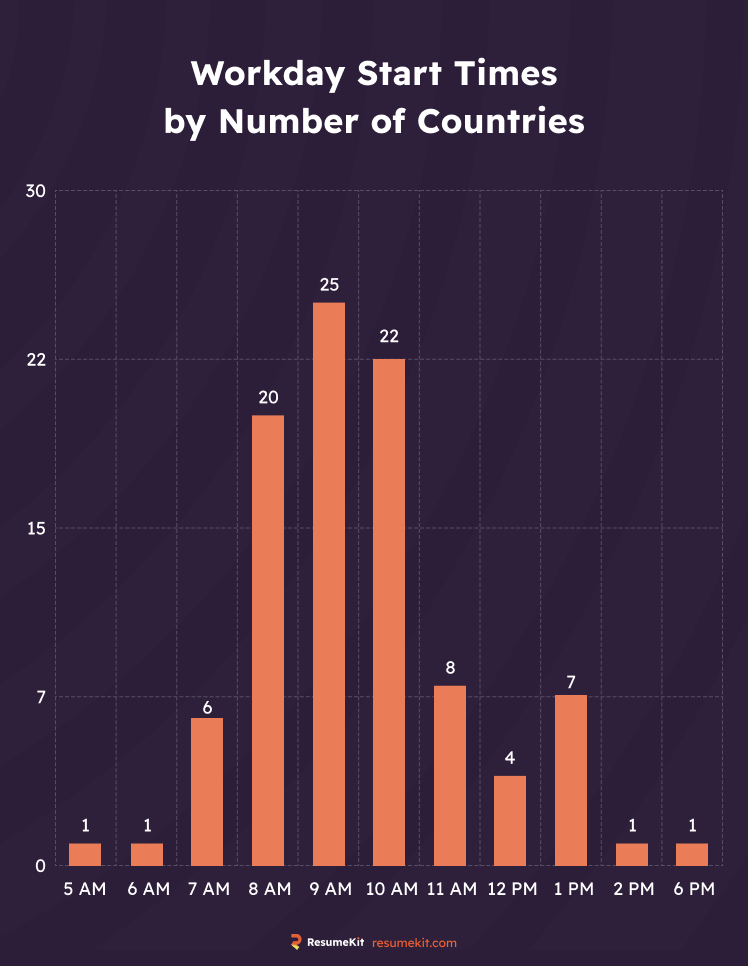
Top countries with the earliest workday start times (weighted averages):
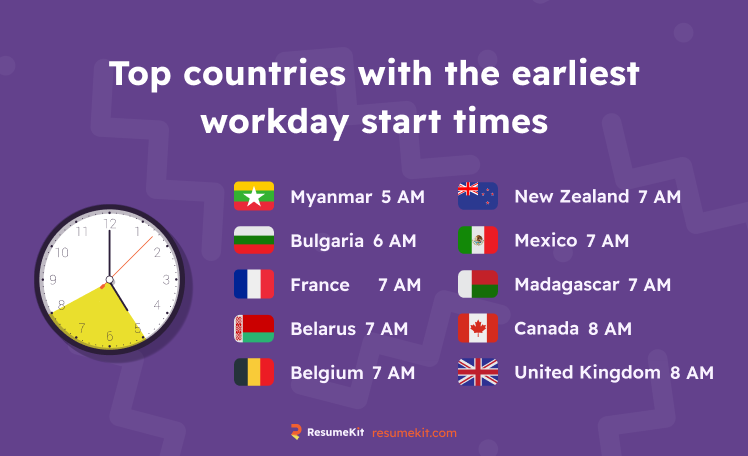
Top countries with the latest workday start times (weighted averages):
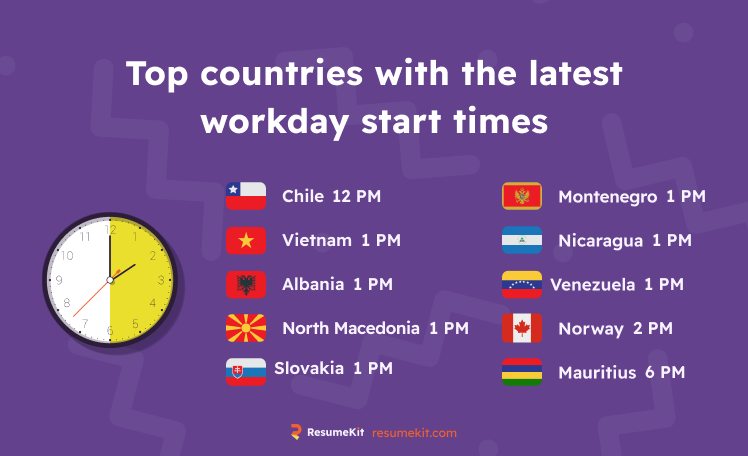
Major European and Western countries frequently align with the most common workday start times:
- United States – 8 AM
- Australia, Italy, Spain, Switzerland – 9 AM
- Germany, Sweden, Ireland – 10 AM